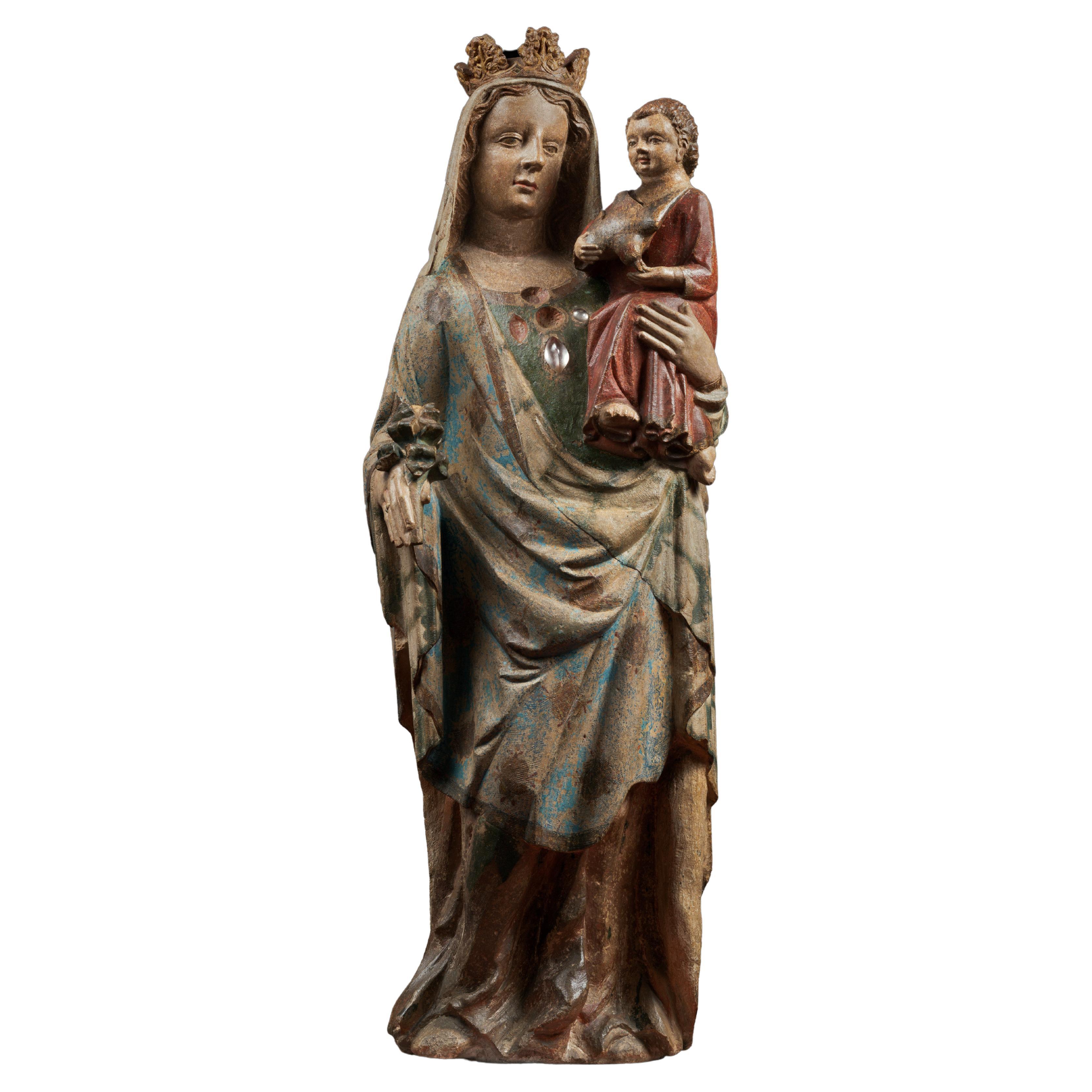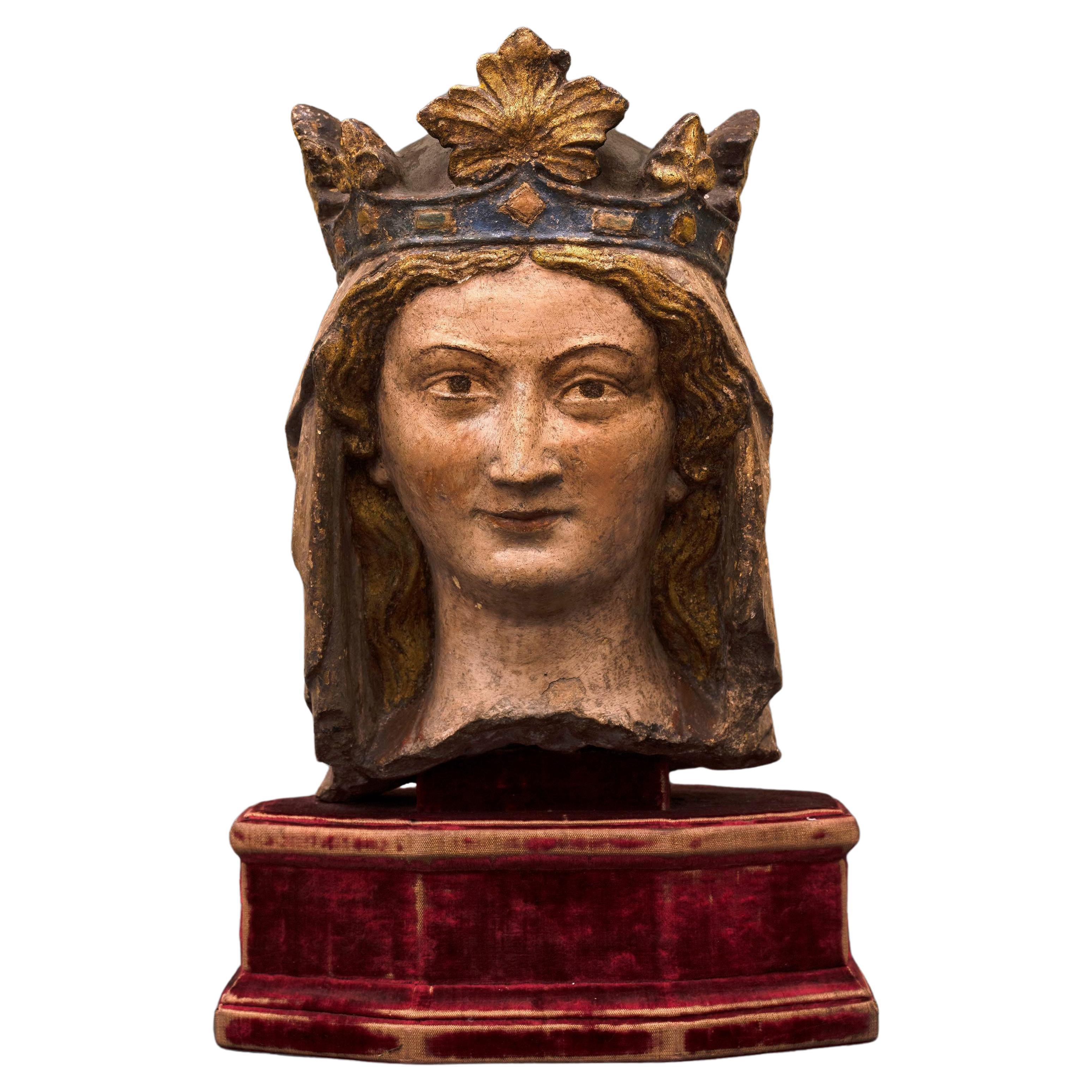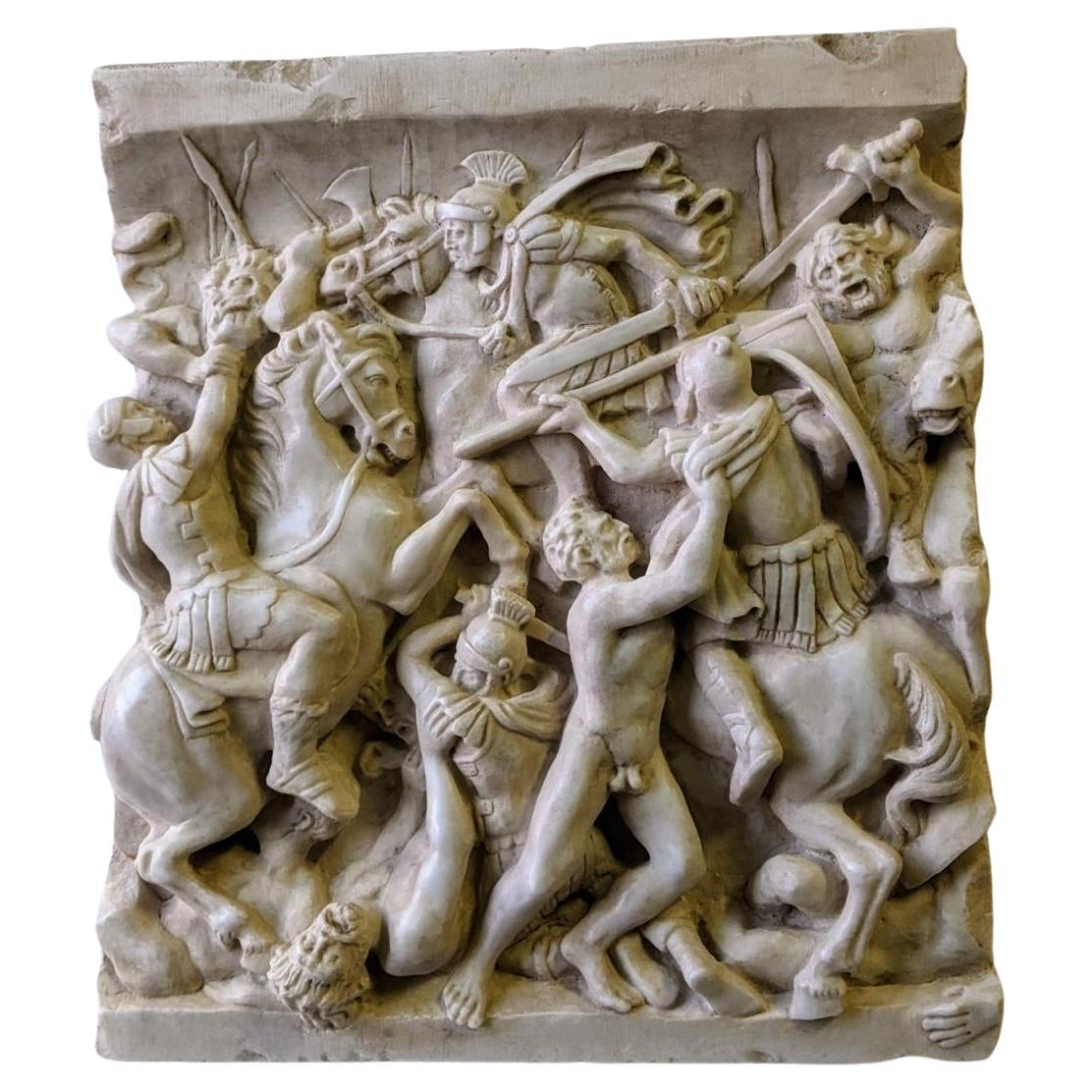Items Similar to Alabaster high relief, Spain 14th century
Want more images or videos?
Request additional images or videos from the seller
1 of 9
Alabaster high relief, Spain 14th century
About the Item
Alabaster plate in high relief illustrating a forgeron working on a metal object (a helmet?). A young woman is in front of him holding in her left hand an ovoid vase or reliquary that she is holding in her right hand.
The scene represented is being studied.
The whole is gracious, accentuated by the inclination of the faces, and was undoubtedly polychromed (numerous traces).
The plate must have been broken in the middle, then stuck back together.
Catalonia, attributed to Bernat SAULET, 14th c., was a sculptor, probably Catalan.[1] Little is known of his biography, but in the Episcopal Museum of Vic is one of his masterpieces, a retable of the Passion, from the church of Sant Joan i Sant Pau de Sant Joan de les Abadesses.
21,5 x 22 cm
modern frame
- Dimensions:Height: 17.32 in (44 cm)Width: 8.46 in (21.49 cm)Depth: 2 in (5.08 cm)
- Style:Medieval (Of the Period)
- Materials and Techniques:
- Place of Origin:
- Period:
- Date of Manufacture:1350
- Condition:Repaired: he plate must have been broken in the middle, then stuck back together. Wear consistent with age and use. Minor structural damages.
- Seller Location:PARIS, FR
- Reference Number:1stDibs: LU8645236699122
About the Seller
No Reviews Yet
Vetted Seller
These experienced sellers undergo a comprehensive evaluation by our team of in-house experts.
Established in 1986
1stDibs seller since 2023
- ShippingRetrieving quote...Ships From: PARIS, France
- Return PolicyA return for this item may be initiated within 3 days of delivery.
More From This SellerView All
- Giltwood and polychrome half-relief representation of Saint Rococo. Spain, 16thLocated in PARIS, FRImportant bas-relief in carved wood with traces of gilt, in an architectural frame with two angels in the corners, representing Saint Rocco. Considered, among other things, the Patro...Category
Antique 16th Century Spanish Renaissance Figurative Sculptures
MaterialsWood
- Large Virgin and Child in polychrome wood, Spain, 16th CenturyLocated in PARIS, FRLarge painted and carved wooden Virgin and Child in the round, representing the Virgin and Child carrying the globe. The theme of the Virgin and Child is the most represented in all ...Category
Antique 1630s Spanish Renaissance Figurative Sculptures
MaterialsWood
- Christ in Boxwood, France, late 16th-early 17th century".Located in PARIS, FRChrist in Boxwood, France, late 16th-early 17th century Beautiful corpse of Christ with missing arms. He must have been on the Cross, arms in a horizontal position. Great expressiv...Category
Antique Early 17th Century French Renaissance Figurative Sculptures
MaterialsBoxwood
- Very large terracotta, Provence 19th centuryLocated in PARIS, FRVery large terracotta ( 1.70m) depicting a young woman raising her garment slightly with her left arm to climb down from a rock. The right arm close to the body, the hand must have b...Category
Antique Late 19th Century French Napoleon III Figurative Sculptures
MaterialsTerracotta
- Large Christ in walnut wood , France 17th or 18th centuryLocated in PARIS, FRLarge Christ on the Cross carved in the round in walnut wood. With great realism, the sculptor has used the wood grain on the bust and to emphasise the shape of the legs. The right p...Category
Antique Late 17th Century Baroque Figurative Sculptures
MaterialsWalnut
- Large Virgin and Child, Tyrol, 16th centuryLocated in PARIS, FRLarge wooden Madonna and Child, painted and carved in hollow at the back. The theme of the Virgin and Child is the most represented in all Christian art, whereas the infancy of Jesus...Category
Antique 16th Century German Renaissance Figurative Sculptures
MaterialsWood, Pine
You May Also Like
- Spanish 16th Century High Relief Limestone Bust from a BuildingLocated in Marbella, ES16th century high relief limestone bust that topped a stone arch. Side heraldic decorations indicate a patron Saint. The face is weathered but the general condition is good.Category
Antique 16th Century Spanish Renaissance Architectural Elements
MaterialsLimestone
- Important 14th Century Polychrome Limestone Virgin from LorraineLocated in Saint-Ouen, FRProvenance : - Kunsthaus Heinrich Hahn, Frankfurt am Main, sale 16, June 17, 1930, lot 16. - Sotheby's, Amsterdam, Feb. 26, 2006, lot 201. HISTORIC Located between Moselle valley and Meuse valley, framed by the Vosges Mountains on the south side and the duchy of Luxembourg on the north side, the duchy of Lorraine is the result of several partitions. It starts with the 9th century when the Carolingian empire is divided, with Lothar 1st inheriting Lotharingia. In 959 this territory was in turn divided in two; Lower and Upper Lotharingia, the latter being the forebear of the duchy of Lorraine. This duchy was under the rule of the Holy Roman Germanic Empire until 1736 when it was absorbed by the kingdom of France. All along its history the duchy of Lorraine has found itself in the midst of many conflicts. Alliances and feuds marking European history were always particularly sensible in Lorraine where instability was frequent. Because of its geographic position the duchy of Lorraine was also an artistic crossroad. Hence the duchy of Lorraine becomes from the 13th century onwards an important artistic centre where a particular type of Virgin and Child appears. According to professor J. A. Schmoll the characteristics of Lorraine sculpture burgeon around 1280-1300 in the Aube region. It presents “vigorous volumes, restrained movements, rare but solemn gestures and a strong interiorised and stern expression”. Those Virgins look similar with a wide forehead, a shield- or oval-shaped face, large neck, small lips and a cleft chin. This model is particularly in favour during the 13th century because of the revival for Marial worship and for the theme of the Virgin and Child. It bears witness to a new religious sensibility with a more intimate vision of religious practice. DESCRIPTION The important 14th century Virgin we present to you is one of the most beautiful examples of sculptural art from Eastern France, with her fascinating distant gaze. Her contrapposto posture is induced by the weight of the child she carries high on her left side. The child has a chubby face framed by blond hair with well defined curls and he wears a long red V-collared tunic from which emerge his feet. The fabric is animated by long folds. The position of the right foot turned to the back is a detail we can notice on several Virgins from Lorraine. He holds a bird that seems to be pecking his thumb. “The bird /held by the child in his hands/ has been read as a reference to an episode from Christ’s childhood when he has moulded sparrows with clay before giving them life. It appears in the apocryphal gospel of Pseudo-Matthew (ch. 27) and later in the Quran (III, 43, v. 110). However the iconography seems to be more influenced by the concept of Redemption or of Eucharist, the bird symbolising the soul of the Christian about to be redeemed or revitalised.” Mary wears a long dress with two rock crystal cabochons remaining from the original five. She is covered by a red cloak enriched with old-gold motifs draped as an apron falling in long pleats along her left hip. The relief treatment and the volume of the cloak developing a network of concentric pleats contrast with the the flat pleating of her dress. They nevertheless suggest the curve of her bent right leg. She wears a floret crown securing a short thin veil carved in very low relief. From it emerges her blond curled hair characteristic of the 13th century. The large face with almond-shaped eyes, straight nose, small lips and cleft chin casts its gaze afar in a fashion typical of 13th century Virgins. In her right hand she holds a lily flower. In a very refined manner the artist has carved a band on her right ring-finger. In the back, carefully sculpted, spreads the minutely detailed short veil. COMPARATIVE STUDIES This sculpture of great quality presents obvious similarities with Virgins from Lorraine, designated by William Forsythe...Category
Antique 15th Century and Earlier French Gothic Figurative Sculptures
MaterialsLimestone
- Gothic crowned Head - Île de France, 14th centuryLocated in Bruxelles, BEHead of a crowned Virgin Île-de-France, first half of 14th century. H26 x 14 x 14 cm Provenance : - Private Collection, Paris France (1960) - Private Collection Tuscany, Italy (19...Category
Antique 15th Century and Earlier French Gothic Figurative Sculptures
MaterialsStone
- High Relief Representing Battle 20th CenturyBy Europa AntiquesLocated in Madrid, ESHigh relief representing battle carved on white Carrara marble dimensions 28.5 x 22 x 4 cm weight 6" kg very good conditionCategory
Early 20th Century Italian Baroque Busts
MaterialsCarrara Marble
- Important German Pietà from the, 14th CenturyLocated in Saint-Ouen, FRIMPORTANT GERMAN PIETÀ FROM THE 14th CENTURY ORIGIN: GERMANY, REGION DE COLOGNE PERIOD: BEGINNING IF THE 14th CENTURY, ca. 1330 Height: 98 cm Length: 45 cm Depth: 33 cm Polychromed linden wood Good condition of conservation Provenance : particular Alsatian collection The theme of the Pietà or Vesperbild appears in Germany at the end of the 13th century, reflecting the mysticism of the late Middle Ages. Although the theme does not exist in the Gospels, it was often mentioned in contemporary devotional literature. Indeed, during the first half of the 14th century, mystical thought and devotional practices changed under the impulse of a number of religious, among them Heinrich Suso and St Bridget. In his writings, Suso placed important emphasis on contemplation and meditation in the footsteps of Christ's martyrdom. This will have great impact in the field of art, especially in Germany and later in France. The emphasis will from now on be on grief, death is shown in a straightforward way. The wounds of Christ are gaping and bloody. The suffering of Christ and the seven sorrows of the Virgin Mary are meditated upon. This piece demonstrates the interest of the faithful in these representations where pathos reigns. The virgin is represented seated in a frontal position. The bust is very elongated. She is wearing a red dress with a simple neckline and a blue mantel...Category
Antique 15th Century and Earlier Figurative Sculptures
MaterialsWood
- 19th Century Italian Orientalist Style Alabaster Relief PlaqueLocated in London, GBThis charming antique panel is carved in the refined Orientalist style, and depicts a tender embrace between man and woman, capturing a moment of emo...Category
Antique Late 19th Century Italian Figurative Sculptures
MaterialsAlabaster
Recently Viewed
View AllMore Ways To Browse
Art Deco Girl In Hoop
Ashanti Wooden Sculpture
Aurore By A Moreau
Biba Figurine
Bisquit Sculpture
Bustamante Moon
Chiparus Pedestal
Cupid Psyche Godet
Equestrian Bronze Marcus
Erotic Bedouin
Federico Cantu
Fertility Ashanti
Frederick Macmonnies
Gebruder Heubach
Gigi Chessa
Grand Tour Bronze Figure Of An Athlete
Greek Runner Bronze
Haas Sisters





